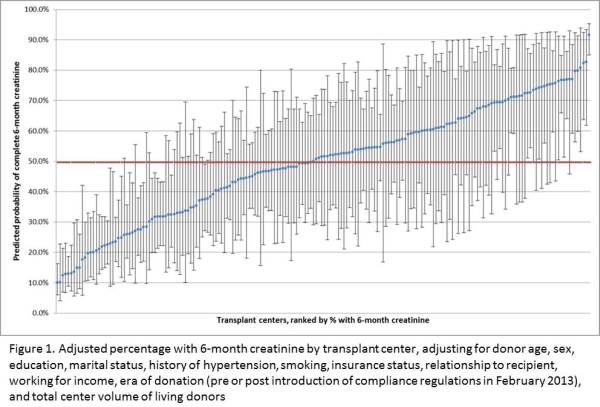Center Variation in Six-Month Post-Donation Follow-Up of Obese Living Kidney Donors
1Surgery, University of Alabama at Birmingham, Birmingham, AL
2Health Care Organization & Policy, University of Alabama at Birmingham, Birmingham, AL
3Medicine, University of Pennsylvania, Philadelphia, PA.
Meeting: 2018 American Transplant Congress
Abstract number: 531
Keywords: Multivariate analysis
Session Information
Session Name: Concurrent Session: Kidney Living Donation: Programmatic Issues
Session Type: Concurrent Session
Date: Tuesday, June 5, 2018
Session Time: 4:30pm-6:00pm
 Presentation Time: 4:54pm-5:06pm
Presentation Time: 4:54pm-5:06pm
Location: Room 6B
Introduction: While post-donation follow-up in the United States has improved since implementation of minimum center compliance standards, it is still suboptimal and brief (only 2 years total required). Despite being at greater risk for developing post-donation kidney failure, living kidney donors with obesity at the time of donation are more likely to have incomplete post-donation follow-up. We sought to examine whether center-level variation exists in follow-up at 6 months post-donation among a cohort of obese living donors.
Methods: Using data from the Scientific Registry for Transplant Recipients and the Organ Procurement and Transplantation Network from January 2005-July 2015, we included all adult kidney donors with obesity (body mass index ≥ 30 kg/m2) at time of donation (n=13,831). We used a multilevel logistic regression model with a random intercept for recovery center and empirical Bayes estimates, to explore the presence of center variation in recording of 6-month post-donation serum creatinine.
Results: After adjusting for various donor and center-level characteristics, 24% of the variation in recording of 6-month serum creatinine was accounted for by center (intraclass correlation coefficient: 0.237, p < 0.001). When examining the predicted probability of 6-month creatinine by center, the adjusted probability ranged from 10% to 91.5%, with an average of 49.5% and 91 of 192 centers had less than 50% predicted probability of complete 6-month creatinine.
Conclusion: Tremendous variation in recording of 6-month post-donation serum creatinine exists among obese living donors across US transplant centers. Given the increased risk for post-donation kidney failure among obese living donors, center-level efforts targeted specifically at increasing post-donation follow-up should be developed and implemented.
CITATION INFORMATION: Reed R., MacLennan P., Shelton B., Mustian M., McWilliams D., Blackburn J., Sawinski D., Locke J. Center Variation in Six-Month Post-Donation Follow-Up of Obese Living Kidney Donors Am J Transplant. 2017;17 (suppl 3).
To cite this abstract in AMA style:
Reed R, MacLennan P, Shelton B, Mustian M, McWilliams D, Blackburn J, Sawinski D, Locke J. Center Variation in Six-Month Post-Donation Follow-Up of Obese Living Kidney Donors [abstract]. https://atcmeetingabstracts.com/abstract/center-variation-in-six-month-post-donation-follow-up-of-obese-living-kidney-donors/. Accessed December 23, 2025.« Back to 2018 American Transplant Congress

